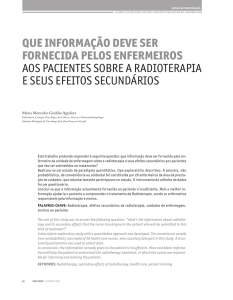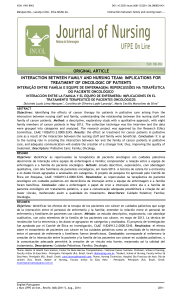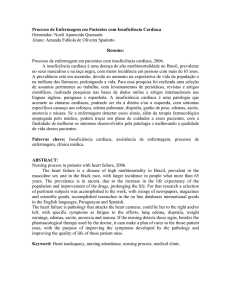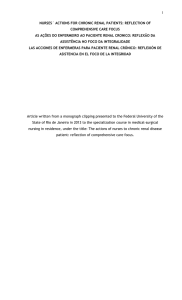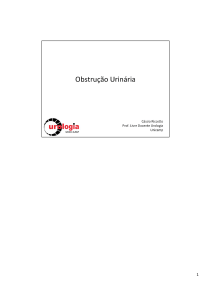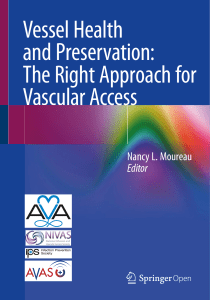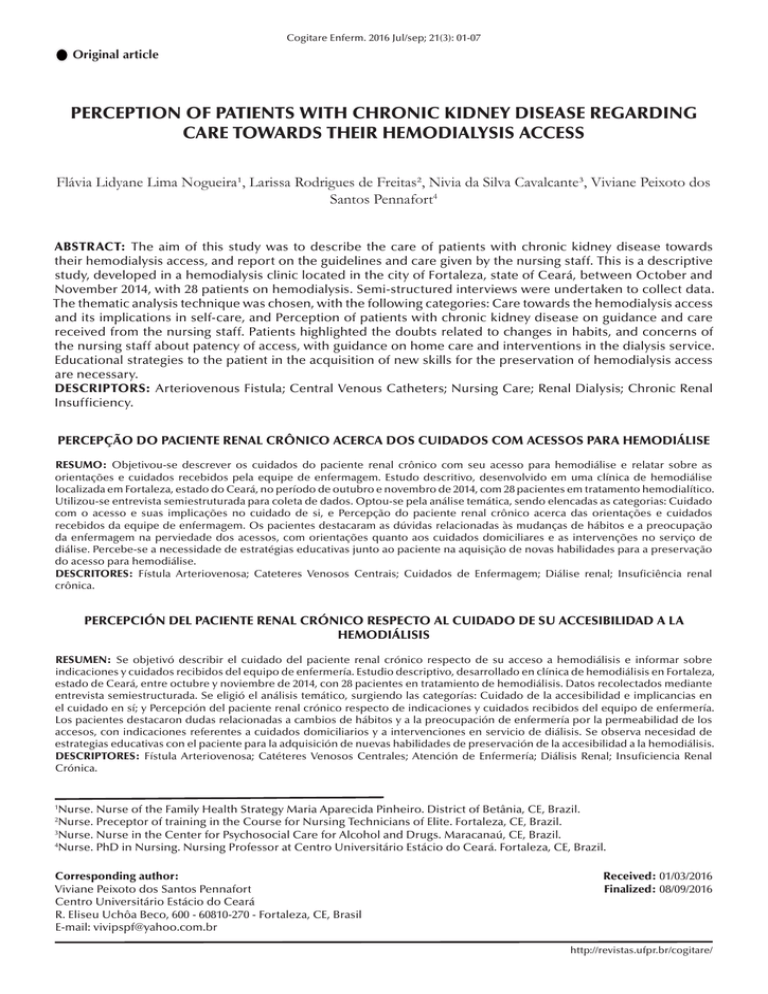
Cogitare Enferm. 2016 Jul/sep; 21(3): 01-07
Original article
PERCEPTION OF PATIENTS WITH CHRONIC KIDNEY DISEASE REGARDING
CARE TOWARDS THEIR HEMODIALYSIS ACCESS
Flávia Lidyane Lima Nogueira¹, Larissa Rodrigues de Freitas², Nivia da Silva Cavalcante³, Viviane Peixoto dos
Santos Pennafort4
ABSTRACT: The aim of this study was to describe the care of patients with chronic kidney disease towards
their hemodialysis access, and report on the guidelines and care given by the nursing staff. This is a descriptive
study, developed in a hemodialysis clinic located in the city of Fortaleza, state of Ceará, between October and
November 2014, with 28 patients on hemodialysis. Semi-structured interviews were undertaken to collect data.
The thematic analysis technique was chosen, with the following categories: Care towards the hemodialysis access
and its implications in self-care, and Perception of patients with chronic kidney disease on guidance and care
received from the nursing staff. Patients highlighted the doubts related to changes in habits, and concerns of
the nursing staff about patency of access, with guidance on home care and interventions in the dialysis service.
Educational strategies to the patient in the acquisition of new skills for the preservation of hemodialysis access
are necessary.
DESCRIPTORS: Arteriovenous Fistula; Central Venous Catheters; Nursing Care; Renal Dialysis; Chronic Renal
Insufficiency.
PERCEPÇÃO DO PACIENTE RENAL CRÔNICO ACERCA DOS CUIDADOS COM ACESSOS PARA HEMODIÁLISE
RESUMO: Objetivou-se descrever os cuidados do paciente renal crônico com seu acesso para hemodiálise e relatar sobre as
orientações e cuidados recebidos pela equipe de enfermagem. Estudo descritivo, desenvolvido em uma clínica de hemodiálise
localizada em Fortaleza, estado do Ceará, no período de outubro e novembro de 2014, com 28 pacientes em tratamento hemodialítico.
Utilizou-se entrevista semiestruturada para coleta de dados. Optou-se pela análise temática, sendo elencadas as categorias: Cuidado
com o acesso e suas implicações no cuidado de si, e Percepção do paciente renal crônico acerca das orientações e cuidados
recebidos da equipe de enfermagem. Os pacientes destacaram as dúvidas relacionadas às mudanças de hábitos e a preocupação
da enfermagem na perviedade dos acessos, com orientações quanto aos cuidados domiciliares e as intervenções no serviço de
diálise. Percebe-se a necessidade de estratégias educativas junto ao paciente na aquisição de novas habilidades para a preservação
do acesso para hemodiálise.
DESCRITORES: Fístula Arteriovenosa; Cateteres Venosos Centrais; Cuidados de Enfermagem; Diálise renal; Insuficiência renal
crônica.
PERCEPCIÓN DEL PACIENTE RENAL CRÓNICO RESPECTO AL CUIDADO DE SU ACCESIBILIDAD A LA
HEMODIÁLISIS
RESUMEN: Se objetivó describir el cuidado del paciente renal crónico respecto de su acceso a hemodiálisis e informar sobre
indicaciones y cuidados recibidos del equipo de enfermería. Estudio descriptivo, desarrollado en clínica de hemodiálisis en Fortaleza,
estado de Ceará, entre octubre y noviembre de 2014, con 28 pacientes en tratamiento de hemodiálisis. Datos recolectados mediante
entrevista semiestructurada. Se eligió el análisis temático, surgiendo las categorías: Cuidado de la accesibilidad e implicancias en
el cuidado en sí; y Percepción del paciente renal crónico respecto de indicaciones y cuidados recibidos del equipo de enfermería.
Los pacientes destacaron dudas relacionadas a cambios de hábitos y a la preocupación de enfermería por la permeabilidad de los
accesos, con indicaciones referentes a cuidados domiciliarios y a intervenciones en servicio de diálisis. Se observa necesidad de
estrategias educativas con el paciente para la adquisición de nuevas habilidades de preservación de la accesibilidad a la hemodiálisis.
DESCRIPTORES: Fístula Arteriovenosa; Catéteres Venosos Centrales; Atención de Enfermería; Diálisis Renal; Insuficiencia Renal
Crónica.
Nurse. Nurse of the Family Health Strategy Maria Aparecida Pinheiro. District of Betânia, CE, Brazil.
Nurse. Preceptor of training in the Course for Nursing Technicians of Elite. Fortaleza, CE, Brazil.
3
Nurse. Nurse in the Center for Psychosocial Care for Alcohol and Drugs. Maracanaú, CE, Brazil.
4
Nurse. PhD in Nursing. Nursing Professor at Centro Universitário Estácio do Ceará. Fortaleza, CE, Brazil.
1
2
Corresponding author: Viviane Peixoto dos Santos Pennafort Centro Universitário Estácio do Ceará
R. Eliseu Uchôa Beco, 600 - 60810-270 - Fortaleza, CE, Brasil
E-mail: [email protected]
Received: 01/03/2016
Finalized: 08/09/2016
http://revistas.ufpr.br/cogitare/
Cogitare Enferm. 2016 Jul/sep; 21(3): 01-07
INTRODUCTION
The care of patients with chronic kidney disease (CKD) undergoing hemodialysis involves
encouraging self-care, infection prevention, providing information to the patient and family regarding
their treatment and complications, as well as providing a safe and comfortable place for the provision
of treatment(1).
Kidney disorders may be acute or chronic. Acute renal failure (ARF) occurs due to a lesion in the
kidney. In this case, the treatment consists of the transient replacement of renal function to reduce
probable complications, and to reduce the risk of lesion enlargement. Chronic kidney disease is also
caused by a kidney lesion, accompanied by a decrease in glomerular filtration rate (GFR)(2).
In 2013, the number of active dialysis units in Brazil was 658 units, with an estimated total of 100,397
patients a year. Of those, 84% underwent dialysis through the Unified Health System (SUS), and 16%
using other healthcare plans. As for dialysis modality, 90% of patients were on hemodialysis, and only
10% on peritoneal dialysis. The age group of 19 to 64 years old showed the highest incidence. The
predominant gender was male, with 58%(3).
When the kidney gets smaller or loses its ability to function normally, it is necessary to use substitutive
methods to keep it alive and with quality of life, such as peritoneal dialysis (PD), hemodialysis (HD),
or kidney transplantation. Of these, the most common is hemodialysis, which consists of removing
solutes accumulated in the blood, such as creatinine, urea, potassium, phosphates, and water, with a
partial restoration of the function performed by the kidneys(2).
To perform hemodialysis, the patient needs a vascular access, such as an arteriovenous fistula (AVF),
a double lumen venous catheter (DLC), or a graft. AVF has become an important means for the patient
on dialysis to carry out treatment, considered a safe method that provides comfort and autonomy
compared to the DLC(4).
The nursing staff is directly involved in the hemodialysis patient care, and nurses should encourage
the development of their self-care capacity through knowledge, which will guide patients to acquire
skills to act in situations of complications with their vascular access(5).
From this perspective, the care of these patients and their vascular accesses by the multiprofessional team is not enough; the patients need to be focused and know about their contributions
to its maintenance. In addition, this care should be performed both in the treatment facility and in the
home environment, encouraging these patients to self-care. Self-care should be jointly built between
professionals and patients, from a chosen priority(6).
Patients’ quality of life can be improved by encouraging self-care. Thus, the nursing staff should
provide support to the patients and make them able to do so, through continuing education reporting
on the illness, limitations, signs and symptoms and, especially, the care with access for dialysis(4).
Because of the complexity of chronic renal failure, kidney disease patients need to receive guidelines
from the nursing staff to act in self-care, because they usually show some difficulty in performing daily
activities related to the treatment(7).
In this context, the aim of the present study was to describe the care of CKD patients towards their
hemodialysis access , and to report on the guidance and care received from the nursing staff.
METHOD
This descriptive qualitative study was carried out between October and November 2014 in a
dialysis clinic in the city of Fortaleza, which currently assists 164 patients from the private network
and healthcare plans. Monthly, it receives an average of 10 new patients. The facility consists of two
hemodialysis rooms, one with 32 machines, and one with four machines. It provides peritoneal dialysis
service and operates with a team of five nurses, 19 nursing technicians, a psychologist, a social worker,
a nutritionist and four physicians.
http://revistas.ufpr.br/cogitare/
02
Cogitare Enferm. 2016 Jul/sep; 21(3): 01-07
Participants were patients with CKD on hemodialysis who met the following inclusion criteria: being
over 18 years old, undergoing hemodialysis, and using a catheter or AVF within a maximum period of 6
months. The exclusion criterion was: patients with no clinical conditions during the collection period.
Data were collected through a semi-structured interview, recorded with the help of a tape recorder,
with the following questions: How do you care for your venous access (catheter or fistula)? What are
the guidelines you received at the service?
The collected data were submitted to thematic analysis(8), by means of the following stages: full
transcription of the interviews, pre-analysis with thorough reading, synthesis of content and exploratory
reading. Data were grouped into sets and subsets that showed the same ideas and were subsequently
reclassified based on the relevance of this study. Thus, two categories emerged: I - Care towards the
hemodialysis access and its implications in self-care; II – Perception of CKD patients on guidance and
care received from the nursing staff.
Initially, the research project was presented to the management of the institution and the nursing
management of the hemodialysis unit, for getting authorization for data collection from patients, and
allowance to access medical records, through a letter of agreement and trustee statement. The study
was submitted to the Ethics Committee of the State University of Ceará - UECE with report no. 229772.
The recorded content was transcribed, protecting the confidentiality and anonymity of patients,
replacing their names with the names of precious stones.
RESULTS
Twenty-eight patients were interviewed. According to the categorization in Table 1, there was
a predominance of women, the prevalent age group was 41-60 years. Of the total, 15 (53.6%) were
married, with an average income greater than or equal to two minimum wages. The main comorbidities
associated with chronic kidney disease were systemic hypertension and diabetes mellitus. Regarding
their venous access, 15 (53.6%) patients were using some kind of central venous catheter, either of
short- or long-term, 13 (46.4%) were using AVF. Nineteen patients (67.8%) started dialysis treatment in
other clinics.
From the analysis of the reports, two categories were listed: I - Care towards the hemodialysis access
and its implications in self-care; II – Perception of CKD patients on guidance and care received from
the nursing staff.
Care towards the hemodialysis access and its implications in self-care
In the statements collected, there was a greater concern for the permanence and maintenance
of the access, which required many home care procedures, with significant changes in lifestyle. The
use of a central venous catheter for hemodialysis causes them more distress when compared to the
arteriovenous fistula, as can be seen in the following reports:
[...] I’m not doing anything, I’m standing, not to hurt [neck]. It made taking a bath very difficult. (Fuchsita)
I try not to wet the catheter. Never wet it, I always put a washcloth on top, or I put a plastic film, and
then I pass a micropore on the sides to try to take a relaxed bath, but I can’t because I can’t get it wet.
The only way I have is to try to prevent the most I can. (Diamond)
Now in the state that I am I just wash it well [AVF] with asseptol, and always use band aid. I change it
every day. Twice a day. (Sapphire)
However, it was observed that each patient adjusts the routines to his/her daily life in the presence
of the access.
[...] I do not sleep on its side [AVF], I always protect it, make exercises with the little ball, when there is
a hematoma, I put ice and hot water. (Carnelian)
http://revistas.ufpr.br/cogitare/
03
Cogitare Enferm. 2016 Jul/sep; 21(3): 01-07
I take great care not to lift weight, I clean my arm
very well [AVF arm]. At night I put an ice pack,
or warm cloth [...]. When I take a shower I use a
special soap for it. (Pyrite)
[...] the only thing I do is to tie a strip here in my
head for it [catheter] not to shake a lot, put a cap
and I’m ready. (Fuchsita)
Perception of CKD patients on guidance and care
received from the nursing staff
Patients’ reports show that the main guidelines
received from the nursing staff on the care for a
central venous catheter were to avoid wetting and
manipulating the central venous access.
[...] They [nursing staff] asked us not to move,
to do everything not to wet it! Not to handle it,
they prefer to handle it here [clinic]. So we do
not touch it [catheter], that is exactly not to have
contamination, anything. (Emerald)
He [nurse] told me not to wet it when having a
shower, to avoid infection. (Ruby)
They tell us not to let anyone touch it, nor
leave it getting dust, [...] to avoid any kind of
contamination. (Tourmaline)
As for care of AVF, patients highlighted the
following guidelines: avoid lifting weight and
sleeping over the arm, do not check blood glucose
on the limb with AVF, do exercises and clean the
arm with AVF.
[...] Do not sleep over the arm, do not lift weight,
do not put anything like that, my diabetes, do not
stick on the arm [do not apply insulin], do not
measure the pressure, anything. (Pyrite)
The required care of washing and doing that
exercise with the ball, always do it. (Bronzite)
Patients also mentioned care in the
maintenance of the central venous catheter
performed by the nursing staff of the dialysis
service. They highlighted the concern from the
staff with the maintenance of the access and
prevention of infection.
Because here, when we get here, he [nurse]
thoroughly cleans it, cleans to avoid infection [...]
and do not have fever [...]. It is very great care that
they [professionals] have with us here. (Ruby)
The dressing is put when in the clinic. (Tourmaline)
Table 1 - Characterization of CKD patients on
hemodialysis, Fortaleza, Brazil, 2014
Characteristics
N
%
Male
11
39
Female
17
61
Gender
Age (in years)
20 - 40
8
28.6
41 - 60
13
46.4
> 60
7
25
Single
6
21.4
Married
15
53.6
Divorced
3
10.8
Widowed
4
14.2
Primary - Complete
4
14.3
Primary - Incomplete
8
28.6
High school - complete
8
28.6
High school - incomplete
3
10.7
Undergraduate course - complete
2
7.1
Undergraduate course - incomplete
3
10.7
≤1
10
35.8
≥2
16
57.1
Does not know
2
7.1
Systemic hypertension
9
32.1
Diabetes mellitus
1
3.7
Systemic hypertension + Diabetes
mellitus
10
35.7
Systemic hypertension + LUPUS
2
7.1
Heart diseases
3
10.7
None
3
10.7
Catheter Permcath
7
25
Short-term
8
28.6
AVF
13
46.4
Peritonitis
1
3.6
Catheter infection
1
3.6
AVF infection
2
7.1
Marital status
Level of education
Family income (in minimum salaries)
Comorbidities
Current access
Report of infection
Treatment beginning
Hospitals and other clinics
19
67.8
Studied clinic
8
28.6
Does not know
1
3.6
For the catheter, the dressing is also put here.
Only here! They [nurses] do not even want us to
http://revistas.ufpr.br/cogitare/
04
Cogitare Enferm. 2016 Jul/sep; 21(3): 01-07
get near [...]. (Hematite)
According to patients’ reports, the main interventions performed by nursing technicians in the
maintenance of the arteriovenous fistula were antisepsis before puncture and hemostasis at the end
of a hemodialysis session.
[...] Even if they will put the needle [nursing technicians] they clean the arm, even when it is already
washed. [...] They put like a band aid to stop bleeding. (Aragonite)
Contradictorily, some reports have highlighted the lack of guidance related to the care of the venous
access.
No, I didn’t receive either. (Carnelian)
No. It seems that it is not to wet it. (Moonstone)
No, the only advice I received was from my vascular physician. (Diamond)
The preference of a patient for the use of an indwelling catheter (Permcath) instead of fistula was
highlighted, because of the technical inability of professionals at the time of fistula puncture, with
consequent loss of function, according to the report:
I prefer to use the catheter instead of a fistula because it is no use to fabricate a fistula if there isn’t a
qualified professional for punching it, I have already lost two fistulas, they [nursing staff] got it wrong
when they had to put the needles. (Diamond)
DISCUSSION
At the time of data collection, a strong link was observed between the nursing staff and the patients,
each professional knows the particularities of each patient, treats them by the name, and families
demonstrate confidence in the team.
In the first category, CKD patients on hemodialysis were concerned about maintaining their access,
reflecting changes in habits and self-care, such as while bathing and the way they sleep, to avoid
complications of the central venous catheter, or of the arteriovenous fistula. It is considered that selfcare emerges from the knowledge and acceptance of the current condition, with new habits, allowing
maintenance of treatment through care with access, and other changes in their daily lives(9).
For self-care to be incorporated in the life context of CKD patients, it is essential to stimulate their
abilities, skills and potential of human reaction, allowing patient’s positive adaptation to the new
lifestyle and control of treatment. This adaptation can be facilitated by the nurse who, through care,
plans educational interventions to help them relearn how to live with the new reality and to survive
with chronic kidney disease(10).
In the second category, the perception of patients on the guidelines regarding care with access for
hemodialysis was observed. Noteworthy, the reports mainly emphasized the patency of the central
venous access and maintenance of AVF operation in order to continue the hemodialysis treatment
to stay alive, since access malfunction is directly involved in the interruption of the procedure, which
brings fatal consequences.
Knowing the operation of hemodialysis is critical for the patients’ process of adaptation to
restrictions, thus improving their contribution to the treatment. Therefore, the nurse, besides assisting
in the procedure, should act as an educator, facilitating the patients’ development in self-care in their
daily lives(10).
It is noteworthy that, for hemodialysis to be performed, the fistula is considered the safest access as
there is low incidence of infection. In this context, a catheter is indicated only in emergency cases of
hemodialysis, or while a fistula matures(11).
It was noticed that patients prefer the fistula, because it improves quality of life by providing greater
convenience and safety in hemodialysis. The catheter, on its turn, although not requiring a puncture
http://revistas.ufpr.br/cogitare/
05
Cogitare Enferm. 2016 Jul/sep; 21(3): 01-07
every time hemodialysis is performed, requires more specific care, and attention with hygiene and
dressings, besides being an inconvenient and aesthetically unpleasant device.
Conversely, a patient highlighted her preference for using the catheter instead of the fistula, and
reported that two fistulas were produced, but were lost because of improper puncture, and that she
was using an indwelling catheter. It is inferred from this report that there is some unreliability about
the inability of some professionals at the time of puncturing the arteriovenous fistula.
Thus, the specificity and complexity of the nursing team performance with the dialysis procedures;
the fragility of CKD patients; the importance of maintenance and competent use of the vascular
access; and the performance of the arteriovenous fistula puncture are the responsibility of the nurse
or nursing technician, provided that they are properly trained; and in the case of a nursing technician,
under guidance and supervision of nurses. Importantly, the first puncture of the fistula is an exclusive
competence of nurses(12).
It is considered that the nurse’s role is to promote well-being of CKD patients undergoing
hemodialysis, within their limits and respecting each one’s choice, emphasizing that each individual is
responsible for the success of their treatment(11).
Participants also reported, in the second category, how care is provided by the professionals at the
service. They expressed the professionals’ concern, especially regarding hygiene and maintenance of
their access, with an emphasis on the prevention of infections.
Catheter infection is associated with lack of aseptic techniques and inadequate handling of these
devices, corroborating the present study(13). To prevent damage to the health of CKD patients undergoing
hemodialysis, the nursing team needs to remain able to act in the promotion and prevention of
complications, providing greater patient confidence in relation to the team(14).
The study showed that the situations experienced by patients in home care with a central venous
catheter or arteriovenous fistula are unique, and that lack of information causes serious losses in
preserving hemodialysis access, which requires individualized multidisciplinary care, with continuous
guidance in order to achieve autonomy in self-care.
It is clear in this context that the role of the nurse-educator should be one of negotiation of care,
enhancement of knowledge, care practices and beliefs of the CKD patients in life restructuring and
coping with daily challenges. In this regard, there is a need for greater involvement of the team in
promoting continuing education of patients with an emphasis on care for the maintenance of means of
treatment and prevention of infection, favoring an effective hemodialysis treatment, thereby improving
quality of life.
FINAL CONSIDERATIONS
In the categories described, it was observed that CKD patients have prior knowledge about the care
for their access; however, they show they are attached to a single speech: do not wet the catheter and
do not sleep or lift weight with the arm with the fistula.
Regarding the work of the nursing staff, the reports pointed out that some patients were not
properly informed about the care for the hemodialysis access; on the other hand, some emphasized
the concern of professionals regarding maintenance and prevention of complications.
Therefore, one should consider the perception that every patient with chronic renal failure has of
the guidelines received for home care in hemodialysis access maintenance. By valuing their suggestions
and questions about daily care, nurses will develop creative strategies in hemodialysis rooms that will
allow communication and understanding of the themes approached.
The findings of this study are restricted to the institution where it was carried out and refer to a
reduced number of participants; however, they were similar to other services. Thus, it is noticeable
that this issue needs further investigation to acquire knowledge from other patients with hemodialysis
access about home care. From this approach, it will be possible to develop training and update courses
http://revistas.ufpr.br/cogitare/
06
Cogitare Enferm. 2016 Jul/sep; 21(3): 01-07
for professionals involved in the planning and implementation of educational activities to CKD patients,
and their family-caregivers.
REFERENCES
1. Frazão CMFQ, Delgado MFD, Araújo MGA, Silva FBBL, Sá JD, Lira ALBC. Cuidados de enfermagem ao paciente
renal crônico em hemodiálise. Rev Rene. 2014; 15(4): 701-9.
2. Riella MC. Princípios de Nefrologia e Distúrbios Hidroeletrolíticos. 5ª ed. Rio de Janeiro: Guanabara Koogan;
2011.
3. Sociedade Brasileira de Nefrologia (SBN). Censo Brasileiro de Diálise [Internet] 2013 [acesso em 23 abr 2014].
Disponível: http://www.sbn.org.br/censo-brasileiro.
4. Maniva SJCF, de Freitas CHA. O paciente em hemodiálise: autocuidado com a fístula arteriovenosa. Rev Rene.
2010; 11(1): 152-60.
5. Sousa CN. Cuidar da pessoa com fístula arteriovenosa: modelo para a melhoria contínua. Rev Port Saúde
Pública. 2012; 30(1): 11-7.
6. Ministério da Saúde (BR). Secretaria de Atenção à Saúde. Departamento de Atenção Especializada e Temática.
Diretrizes clínicas para o cuidado ao paciente com doença renal crônica – DRC no Sistema Único de Saúde.
Brasília: Ministério da Saúde; 2014.
7. de Ferreira AFA. O papel do enfermeiro na assistência de enfermagem ao paciente em tratamento hemodialítico
(Revisão de Literatura) [monografia]. Recife: Instituto Nacional de Ensino e Pesquisa; 2014.
8. Minayo MCS. O Desafio do Conhecimento. 10ª Ed. São Paulo: Hucitec; 2007.
9. Roso CC, Beuter M, Kruse MHL, Girardon-Perlini NMO, Jacobi CS, Cordeiro FR. O cuidado de si de pessoas
em tratamento conservador da insuficiência renal crônica. Texto Contexto Enferm. 2013;22(3):739-45.
10. dos Santos I, Rocha RPF, Berardinelli LMM. Necessidades de orientação de enfermagem para o autocuidado
de clientes em terapia de hemodiálise. Rev. bras. enferm. 2011; 64(2): 335-42.
11. das Neves Júnior MA, Petnys A, Melo RC, Rabboni E. Acesso Vascular para Hemodiálise: O que há de novo. J
Vasc Bras. 2013; 12(3): 221-5.
12. Conselho Regional de Enfermagem de São Paulo (COREN – SP). Parecer n. 042, de 29 de maio de 2013.
Competência do profissional de Enfermagem para punção de fístula arteriovenosa. [Internet] 2013 [acesso em 18
mai 2016]. Disponível: http://portal.coren-sp.gov.br/sites/default/files/parecer_coren_sp_2013_42.pdf.
13. Grothe C, Belasco AGS, Bittencourt ARC, Vianna LAC, Sesso RCC, Barbosa DA. Incidence of bloodstream
infection among patients on hemodialysis by central venous catheter. Rev. Latino-Am Enfermagem. 2010; 18(1):
73-80.
14. Santana JCB, Fortes NM, Monteiro CLA, Carvalho IM, Leonardo LMU, de Albuquerque PG. Assistência
de enfermagem em um serviço de terapia renal substitutiva: implicações no processo de cuidar. Enfermagem
Revista. 2012; 15(2): 168-78.
http://revistas.ufpr.br/cogitare/
07

